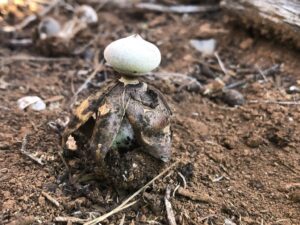This year’s national fungi bioblitz was indeed the largest in Australia’s history, with 13,309 records of 1,131 species contributed by 1,973 participants nationwide over the month of May.
Of the 13,309 records, we had 4,208 sightings contributed on QuestaGame, and 9,101 contributed via iNaturalist.
We congratulate the overall winners of the game component:
Most Valuable Player – KatieS – score of 167,993 (Spotting score plus identification score), her prize is a 2 nights/3 days ‘Nature Realm Stay’ with Guardians of Earth
Champion Identifier – Otto
Best Find – Bronwen16 for her sighting of a Russula.
The other “Best Find” on QuestaGame based on points was a Gliophorus in NSW.
We also had interesting sightings on QuestaGame of Lactarius aff. Glaucescens, Hypocrea pulvinatum, Rosellinia sp., Colus hirudinosus, pin mould Spinellus aff. fusiger, and an insect associated with fungi – a fungus fly Tapeigaster aff annuupes.
Of the iNaturalist observations, we were very pleased to see records of some rarely seen fungi as well as a fungus never previously recorded in Australia!

Fungimap member Eleanor Brand was out documenting fungi with her kids in the Blue Mountains when she came across some spindly stipes with small powdery brown ball caps growing out of the beak and feathers of a decomposing bird carcass! After identifying it as Onygena corvina (Feather Stalkball) on iNaturalist, Eleanor realised this species had never before been documented in Australia. She contacted international Onygena expert Noah Siegal who confirmed the species. After organising for collecting permission from the local council, Eleanor made a collection which has been submitted to the fungarium at Royal Botanic Gardens Victoria, where Luke Vaughan and Tom May are carrying out DNA sequencing and examination of the microscopic features. Such a fantastic example of citizen science in action! Be sure to keep an eye out for this species growing on the beak and feathers of bird carcasses.

We also received some lovely observations of Cortinarius vinaceolamellatus in south west WA, only the third and fourth time this had been recorded on iNaturalist.
Our eye was also caught by an observation of Pleurotus australis from the Sir Joseph Banks Group Conservation Park on a small island off the Eyre Peninsula in SA, the kind of island where we have few fungi records.
In terms of our focus regions, we had approximately 230 records come in for the Murraylands and Riverland region via iNaturalist, as well as 138 records for the region on QuestaGame. The highlights for this region were:
Beaked Earthstar – Geastrum pectinatum
Arched Earthstar – Geastrum fornicatum
White Punk – Laetiporus portentosus
Stalked Puffballs – Tulustoma
Ghost Fungus – Omphalotus nidiformis

Congratulations to the prize winners for the Murraylands and Riverland region:
Champion Spotter – Belinda
Champion Identifier – Pam O’Sullivan
Best Find – David for his sighting of Gymnopilus junonius
The Toowomba region received 6 records, including a Battarrea phalloides(Sandy Stilt-Puffball). We also received an interesting bracket fungus in outback Queensland that appeared to be holding a bank together!
The Lord Howe Island region had 10 records contributed, including a Ghost Fungus and Craterellus odoratus.
The Fungi Quest is a snapshot of Australia’s fungal diversity at a given moment in time. We will continue holding the event at different times of year to try and optimise fungi sightings around the country.
We again thank Catherine Marciniak and Steve Axford for providing the beautiful event video which was viewed more than 4000 times across platforms.
We greatly appreciate everyone’s efforts through May to both document fungi seen as well as verify other people’s sightings! Congratulations everyone on another Great Aussie Fungi Quest.
This project was supported by the Murraylands and Riverland Landscape Board through funding from the landscape levies.


